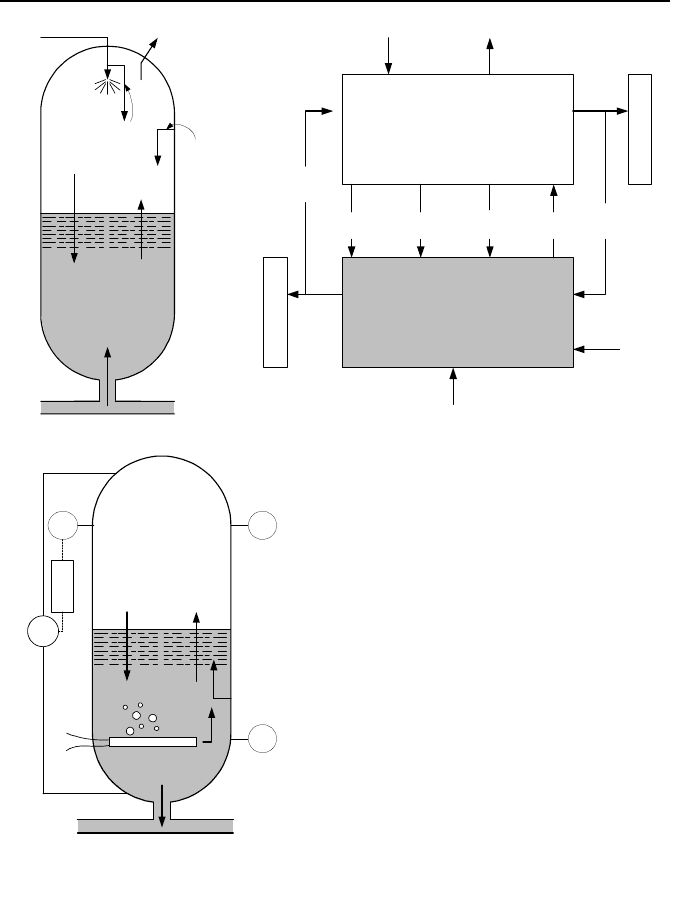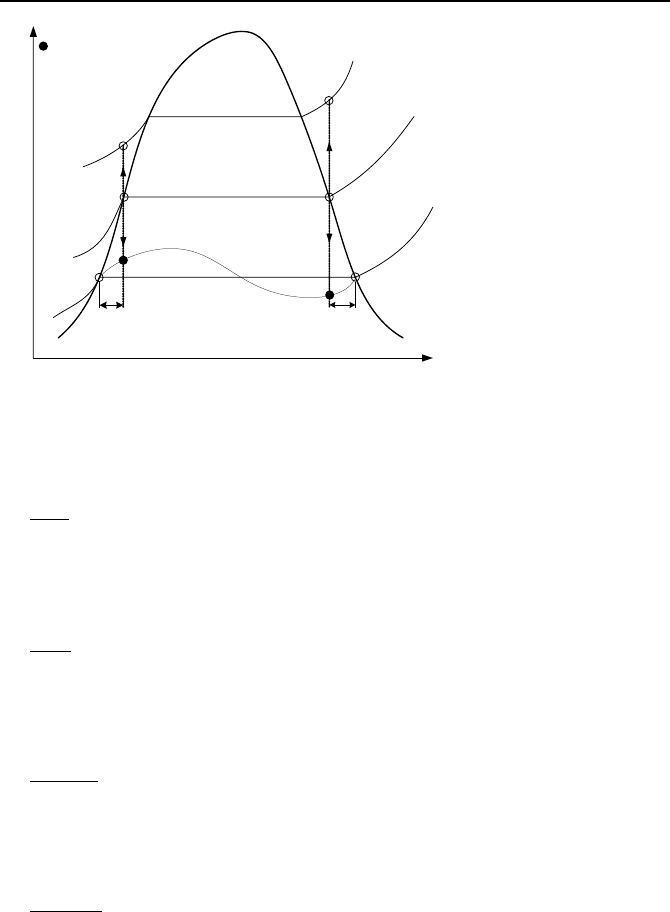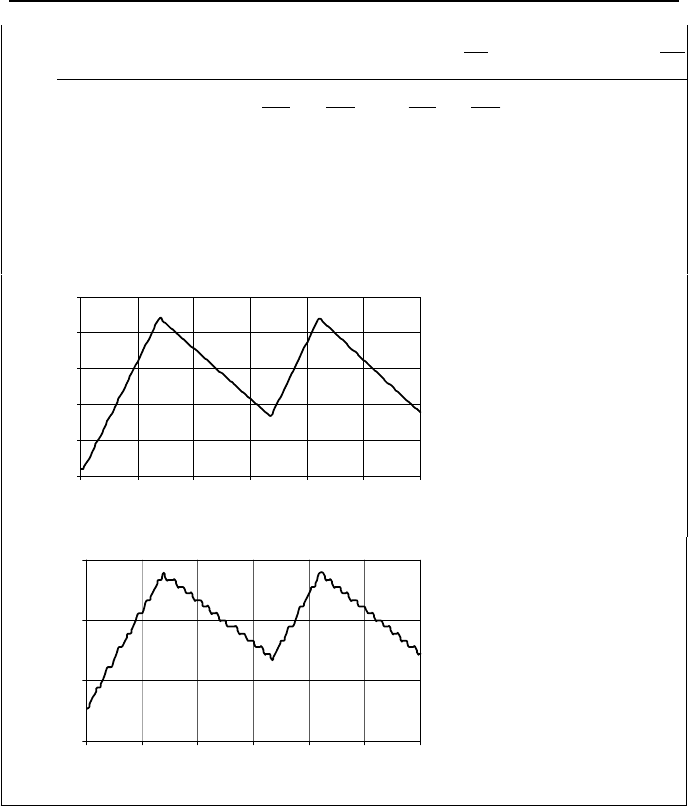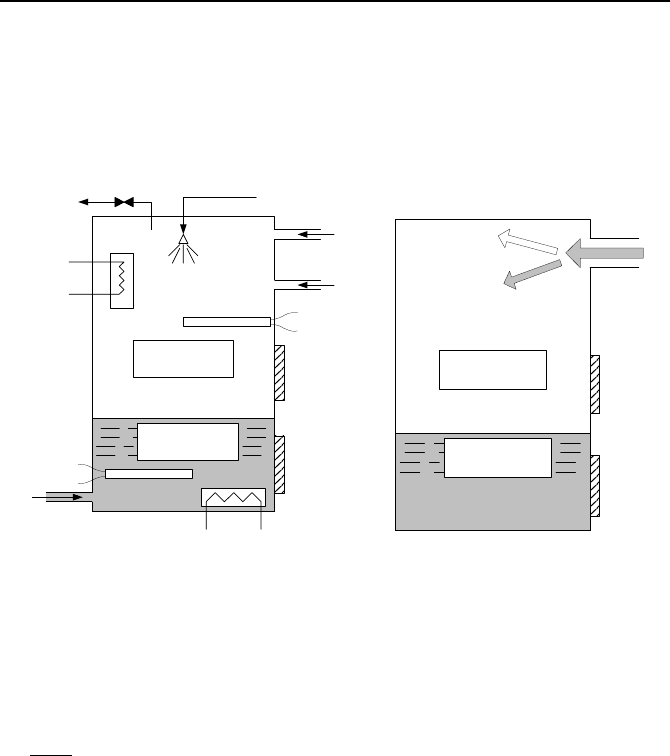Massoud M. Engineering Thermofluids: Thermodynamics, Fluid Mechanics, and Heat Transfer
Подождите немного. Документ загружается.


812 VId. Applications: Simulation of Thermofluid Systems
the spray control valve injecting colder water from the cold leg into the vapor
space. Additional relief is provided by the chemical and volume control system
(CVCS) by opening the letdown valve and allowing water to flow to the CVCS
tank. Manual depressurization of the pressurizer is also possible by remote open-
ing of the PORVs.
Power decrease. Events leading to a drop in the reactor power cause the water
temperature, and hence, the water specific volume to decrease. The subsequent
drop in the RCS water volume is compensated by the pressurizer water rushing to
the RCS through the surge line. This results in the expansion of the bulk vapor
space and a drop in the pressurizer pressure. Pressure is partially restored due to
the flashing of water in the pressurizer. Additionally, the pressurizer heaters are
activated by the pressure controller. If water drops below the low level set point,
indicating the likelihood of heaters to be uncovered, the positive displacement
charging pumps are automatically started to add coolant to the RCS from the
CVCS tank.
Wall effect. The pressurizer wall also participates in the pressure control
mechanism. During an in-surge, when steam may become superheated, the colder
wall acts as a heat sink to condense some steam. In an out-surge, the warmer wall
would heat up the expanding steam, which helps prevent excessive pressure drop.
Also, during an out-surge, the warmer wall may result in boiling water adjacent to
the wall. Hence, the heat transfer regime between wall and the fluid is either natu-
ral convection or results in the change of phase.
Mass and energy processes. Various mass and energy processes are discussed
below. In this discussion, we use subscript l to represent the water region and v
for the vapor region. To be consistent, we use subscripts f and g to represent the
saturation properties. Hence, h
l
stands for the enthalpy of water. If h
l
= h
f
then
the water is saturated. Otherwise, it is subcooled. Similarly, if h
v
= h
g
then the
steam is saturated. Otherwise, it is superheated. Figure VId.5.1 shows the various
mass and associated energy transfer rates between regions. These include:
– surge flow rate to or from the water region, (
susu
hm ,
). In an in-surge, h
su
=
h
HL
and in an out-surge h
su
= h
l
– spray flow rate, to lower pressure, added to the water region (
spsp
hm ,
)
– spray condensation flow from the steam region to the water region (
fsc
hm ,
)
– flashing from the water to the steam region due to depressurization (
gfl
hm ,
)
– rainout from the steam to the water region due to depressurization (
fro
hm ,
)
– wall condensation from steam to the water region (
fwc
hm ,
)
– wall boiling from water to the steam region (
gwb
hm ,
)
– safety and relief valve flow rate from the steam region (
vrv
hm ,
)

5. Mathematical Model for PWR Components, Pressurizer 813
Wall
condensation
In-surge
Evaporation
Condensation
Spray
Spray
condensation
Safety/relief
valve flow
Hot leg
Steam Region
(v)
Water Region
(l)
fsp
hm
fro
hm
gfl
hm
susu
hm
spsp
hm
vsrv
hm
fsc
hm
Q
fwc
hm
vwc
hm
lwb
hm
Wall
Wall
gwb
hm
Flash
Rain out
Wall
boiling
Heater
boiling
Out-surge
L
P
T
T
Conputer
Hot Leg
+
-
Figure VId.5.1. Various mass and energy processes in a PWR pressurizer
– condensation on and evaporation from the bulk interface (
fic
hm ,
and
),
gie
hm
, not shown on Figure VId.5.1
– non-condensable gases, released into the steam region (-).

814 VId. Applications: Simulation of Thermofluid Systems
– heater power in the water region and heat transfer to wall from water and
steam, (
h
Q
),(
lw
Q
) and (
vw
Q
).
Pressurizers use a surge sparger to dampen the momentum of the in-surge. The
penetration depth of the in-surge water to the water region is generally limited to
about 30 cm (1 ft).
Mathematical model. Generally, the extent of information obtained from a
mathematical model depends on the degree of complexity of the model. While we
may make reasonable assumptions to simplify a model, we should be careful
about the effect of such assumptions on the accuracy of the results. For example,
we may use one control volume to represent the entire pressurizer by assuming
that water and steam are well mixed and remain at one pressure and temperature
during a transient. While this approach simplifies the analysis it may actually lead
to erroneous result in case of an in-surge into the pressurizer. During an in-surge,
the bulk vapor region is compressed causing the pressurizer pressure to rise (con-
densation of steam on the colder wall somewhat reduces the rate of pressure in-
crease). On the other hand, by using a one-node model in which the colder in-
surge water mixes with the steam and water mixture, we would calculate a drop in
the pressurizer pressure.
In a two-region model, we consider two deformable control volumes for the
bulk water and bulk vapor region. We use the term “bulk” to distinguish the water
droplets in the bulk vapor region from water in the bulk water region and steam
bubbles in the bulk water region from steam in the bulk vapor region. A three re-
gion model could allocate another deformable control volume to the colder in-
surge in the lower portion of the pressurizer and a four region model could allo-
cate a deformable control volume to each of the bulk water region, bulk vapor re-
gion, drops in the bulk vapor region, and bubbles in the bulk water region.
Example VId.5.1. In a transient, water rushes into the pressurizer at 58.94 lbm/s
for 17.5 seconds at an average pressure and temperature of 700 psia and 450 F.
Estimate the pressurizer pressure. Ignore any interaction at the wall and at the
bulk fluid interface. Assume that the pressurizer is a right circular cylinder, no
spray or safety valve is actuated, and ignore condensation on the wall.
Data: V
Pressurizer
= 700 ft
3
, V
water
= 100 ft
3
, T
inital
= 500 F (P
initial
= 680.86 psia).
Solution: a) No mixing assumption: If the transient is fast and there is not suffi-
cient time for perfect mixing, we may find the peak pressure by assuming isen-
tropic compression of the steam region.
Initially, at P= 700 psia and T = 450 F, v
su
= 0.01939 ft
3
/lbm and h
su
= 430.38
Btm/lbm. To find the steam volume after compression, we need the in-surge mass
and total volume:
tmm
susu
∆=
= 58.94 × 17.5 = 1031.45 lbm

5. Mathematical Model for PWR Components, Pressurizer 815
Table VIc.5.2. Thermodynamic states in a 2-region model
h
v
< h
g
h
v
= h
g
h
v
> h
g
h
l
< h
f
h
l
< h
f
h
l
< h
f
h
l
= h
f
h
l
= h
f
h
l
= h
f
h
l
> h
f
h
l
> h
f
h
l
> h
f
Hence, V
su
= m
su
v
su
= (58.94 × 17.5) × 0.01939 = 20 ft
3
. The steam volume fol-
lowing compression is:
(V
steam
)
2
= (V
steam
)
1
– V
su
= 600 – 20 = 580 ft
3
We find P
2
from Equation IIa.4.3:
P
2
= P
1
[(V
steam
)
1
/(V
steam
)
2
]
(0.445/0.335)
= 680.86 × (600/580)
1.328
= 712.2 psia.
b) Perfect mixing assumption: At T
1
= 500 psia, v
f1
= 0.0204 ft
3
/lbm, v
g1
= 0.6749
ft
3
/lbm
m
1
= m
f1
+ m
g1
= 4901 + 889 = 5790 lbm and x
1
= 0.153 so that u
1
= 486.1 + 0.153
× 631 = 572.98 Btu/lbm
Using Equation IIa.6.4 gives: dtmudhm
ii
/)(=
. The integration of this equa-
tion yields: m
2
u
2
= m
1
u
1
+ m
su
h
su
u
2
= [m
1
u
1
+ m
su
h
su
]/(m
1
+ m
su
) and v
2
= V/(m
1
+ m
su
)
m
2
= m
1
+ m
su
= 5790 + 103.45 = 6821.7 lbm
u
2
= [5790 × 572.98 + 500 × 613]/6821.7 = 839 Btu/lbm
v
2
= 1000/22,222 = 0.045 ft
3
/lbm
Pressure corresponding to v
2
= 0.045 ft
3
/lbm and u
2
= 839 Btu/lbm is P
2
= 672.85
psia. This model predicts a drop in pressure following the in-surge.
5.1. Two-Region Pressurizer Model
Development of the two-region mathematical model for the pressurizer is based
on the Nahavandi method. We allocate one deformable control volume to the bulk
water and another to the bulk vapor region. To find the various thermodynamic
states of these two control volumes, we compare the enthalpy of each region (h
l
and h
v
) with h
f
(P) and h
g
(P). There are a total of 12 possible states as shown in
Table VIc.5.2. However, we do not consider the meta-stable states where h
l
> h
f
and h
v
< h
g
. These meta-stable states are shown in Figure VIc.5.2 for a depres-
surization process from an initial pressure of P
o
to a final pressure of P
o
– ∆P. By
not allowing such meta-stable states, we need to consider only four cases of a)
saturated liquid, superheated vapor, b) saturated liquid, saturated vapor, c) sub-
cooled liquid, saturated vapor, and d) subcooled liquid, superheated vapor. Select-
ing P and h as the state variables for each region, we begin with Equation IIa.5.1
and include all the transfer terms explicitly. For the water region we find:

816 VId. Applications: Simulation of Thermofluid Systems
Flashing Rainout
Temperature
Specific Entropy, s
P
Initial
= P
o
P
2
= P
o
+ ∆P
P
1
= P
o
- ∆P
v
1
v
o
v
2
l
2
l
o
l
1
Metastable State
:
Figure VId.5.2. Isentropic rainout and flashing in a pressurizer during an out-surge tran-
sient (Todreas)
()
l
j
jieic
c
swcraflspsu
l
mmmmmmmmm
dt
dm
¦
=−++++−+=
and for the vapor region, the conservation equation of mass, Equation IIa.5.1 be-
comes:
()
v
j
jieicrv
c
swcrofl
v
mmmmmmmm
dt
dm
¦
=+−−−−−=
We now use the conservation equation of energy for the water region, Equa-
tion IIa.6.4-1, to obtain:
()
V
ll
su su sp g ro wc
ffl f f
wc ic ie g
ff hlwl
dmh
mh mh mh mh m h
dt
mh mh mh Q Q c P
=+−+++
+−+−+
and apply Equation IIa.6.4-1 to the vapor region to obtain:
()
()
V
wc
vv
sp sp g ro wc
ffl f f
rv v ic ie g vw v
ff
dmh
mh h mh mh mh
dt
mh mh mh mh Q c P
=−+−−−
−−+−+
Note that there is no shaft work and the shear work is ignored. Following the
same method used in Chapter IIa to analyze the dynamics of gas-filled rigid ves-
sels, we write the conservation equations as:

5. Mathematical Model for PWR Components, Pressurizer 817
()
[]
k
j
j
k
m
dt
dm
¦
=
for mass in each control volume or region and as:
()
()
[]
PWQhm
dt
hmd
k
k
j
sjjjj
kk
V+
¦
++=
for energy. Subscript j represents the various processes associated with a region
and subscript k is a region index. We now make use of the volume constraint as
V
l
+ V
v
= V where V is the total volume of the pressurizer. Taking the derivative
of the volume constraint relation and setting it to zero yields:
()
0
vv
vvv
)v(
=
¦
»
»
¼
º
«
«
¬
ª
¸
¸
¹
·
¨
¨
©
§
∂
∂
+
∂
∂
+=
¦
+= P
P
h
h
mmmm
dt
md
k
k
k
kkkkkkk
kk
VId.5.1
where in Equation VId.5.1, the summation is over the two regions of liquid and
vapor. Hence, k = l and v. Also in Equation VId.5.1 noting that v = f(P, h), the
derivative of the specific volume of each region was expressed in terms of the par-
tial derivatives with respect to pressure as well as the enthalpy of each region. We
now carry out the derivatives of the energy equations. For the bulk liquid region
we find:
()
[]
[]
{
}
ll
j
j
l
j
sjjjjl
mhmPWQhmh /V
1
¦
−+
¦
++=
Similarly, for the bulk vapor region, the enthalpy derivative becomes:
()
[]
[]{}
vv
j
jvv
j
sjjjjv
mhmPWQhmh /V
¦
−+
¦
++=
Substituting the enthalpy derivatives (
l
h
and
v
h
) into Equation VId.5.1 while
also substituting from the conservation equations of mass we find the pressurizer
pressure derivative as:
()
()
()
[]
¦
°
¯
°
®
¿
¾
½
+
¦
¿
¾
½
¯
®
¦
−
¦
+++
¦
−=
k
k
k
k
k
k
k
k
k
k
k
j
j
j
k
sjjjjk
j
j
hP
m
h
hmWQhmm
P
∂
∂
∂
∂
∂
∂
v
V
v
v
v
k
VId.5.2
Similar to the solution of Section 3, back substitution of pressure derivative results
in finding the enthalpy derivatives. The mass and enthalpy of each region are then
found by integration over each time step. As seen from Equation VIc.5.2, we also

818 VId. Applications: Simulation of Thermofluid Systems
need the derivatives of the properties. Such derivatives can be obtained by various
means. For example, if properties are represented by least square fit to the data,
we can then take the derivatives of the related functions.
This method of solution resulted in the explicit derivation for the control vol-
ume pressure. We used five equations (two conservation equations of mass, two
conservation equations of energy, and one volume constraint) and we found five
unknowns (P, h
l
, h
v
, m
l
, and m
v
). This in turn requires all other terms to be ob-
tained from the related constitutive equations and the equations of state. There-
fore, we need constitutive equations for such mass flow rates as flashing, rainout,
spray condensation, wall condensation, surface evaporation, and condensation. If
the pressurization of the vapor region results in the opening of a safety or relief
valve, the corresponding flow rate is calculated from the momentum equation. If
flow happens to be choked in a relief valve, the momentum equation appears in
the form of the critical flow for the related valve.
5.2. Constitutive Models, Spray Condensation
To be able to find pressure from Equation VId.5.2, in general we need to find con-
stitutive equations for various mass flow rates. Constitutive equations are also
needed for the rate of heat transfer to or from a region. An example for such an
equation includes a model for the estimation of the rate of steam condensation on
the spray droplets injected into the steam region. If we assume that the subcooled
spray flow rate reaches saturation to condense steam, a steady state energy balance
predicts the rate of steam condensation as:
sp
fs
spf
sc
m
hh
hh
m
−
−
=
where h
sp
and h
s
are the spray and the steam enthalpy, respectively. In this rela-
tion, we assumed that steam is saturated, then h
s
= h
g
.
Example VId.5.2. A PWR pressurizer, operating at steady state condition at
15.51 MPa, is suddenly subject to a constant in-surge flow rate for 1 minute. De-
termine the pressurizer response to this event. For this purpose, use a two-region
model for water and steam, ignore all transport processes at the fluid-fluid and
solid fluid interfaces including water flashing to steam.
Data: D = 2.5 m, H = 10 m, V
water
= 25 m
3
, surge flow rate = 7 kg/s for 60 s, surge
enthalpy = 1442 kJ/kg, A
rv
= 1E-4 m
2
, C
D
= 0.61, (P
Actuation
)
rv
= 17 MPa, (P
Reset
)
rv
=
16 MPa. Subscript rv stands for relief valve.
Solution: The rate of pressurization is given by Equation VId.5.2, which for a
two-region system becomes (subscripts i and e stand for into and exit from a re-
gion, respectively):

6. Mathematical Model for PWR Components, Containment 819
()( )
[]
()
[]
()
[]
12
111 2 22 111 1 222 2
12
12 12
12 12
12
vv
vv
vv vv
VV
ie i e iie i iie i
mm m m mhh Q mhh Q
hh
P
mm
PP hh
∂∂ ∂∂
∂∂ ∂∂
∂∂
Σ−Σ +Σ−Σ +Σ − +Σ +Σ − +Σ
∂∂
=−
+++
§·
§·
¨¸
¨¸
©¹
©¹
In this equation
1i
m
Σ =
su
m
,
1e
m
Σ = 0, 0
2
=
i
m
and
rve
mm
=
2
.
Since no heater power is given and there is no interface heat transfer
0
21
== QQ
. The FORTRAN program is included on the accompanying CD-
ROM. The results for pressure and steam temperature are shown below.
15.50
15.55
15.60
15.65
15.70
15.75
0 20 40 60 80 100 120
Time (s)
Pressu re (M Pa)
344.50
345.00
345.50
346.00
0 20 40 60 80 100 120
Time (s)
Vapor Temperature (C
)
6. Mathematical Model for PWR Components, Containment
In addition to bulk water and bulk vapor regions, often control volumes may also
include non-condensable gases in the bulk vapor region. Examples include the
pressurizer with accumulated fission gases and the BWR and PWR plant contain-
ment. To solve for the pressures and temperatures, we use the method of Sec-
tion 5. To simplify the formulation, we assign subscripts 1, 2, and 3 to water in
the pool, steam in the bulk vapor region, and gas in the bulk vapor region. Fig-
ure VId.6.1(a) shows a system which consists of two control volumes, one for the
bulk water region or the pool and one for the bulk vapor region. Various proc-

820 VId. Applications: Simulation of Thermofluid Systems
esses can take place for the system shown in Figure VId.6.1(a) including water
addition to or removal from the pool region, steam and gas addition or removal
from the bulk vapor region, heat addition or removal from each region, and spray
addition to the bulk vapor region. Figure VId.6.1(b) shows steam injection into
the bulk vapor region and the associated division of the injected two-phase into
water and steam.
Heat Sink
Heat Source
Heat Sink
Steam Injection
Gas Injection
Water Injection
Bulk Water Region
(Water : 1)
Bulk Vapor Region
(Steam : 2, Gas: 3)
Heat Source
Wall
Wall
Two-Phase
Injection
Bulk Water Region
(Water : 1)
Bulk Vapor Region
(Steam : 2, Gas: 3)
Wall
Wall
Steam
Water
(a) (b)
Figure VId.6.1. (a) A control volume with water and a mixture of steam and gas and (b)
Division at the break
Following the method of Section 5, we write the conservation equations of
mass for water in the bulk water region, steam in the bulk vapor region, and gas in
the bulk vapor region:
k
k
dt
dm
α
= VId.6.1
where for water in the bulk water region
¦
−−−++++==
wbevflrowcscspinj
mmmmmmmmm
1,1,1
α
,
for steam in the bulk vapor region,
¦
−−−−+++==
2,2,2
2,
srvrowcscevwbflinj
mmmmmmmmm
α
,
and for gas in the bulk vapor region,
¦
−==
3,3,3,3 srvinj
mmm
α
where sub-
script in refers to the two-phase injection into the bulk vapor region. Other sub-
scripts are the same as for pressurizer in Figure VId.5.1.

6. Mathematical Model for PWR Components, Containment 821
Unlike the conservation equation of mass, we write two conservation equations
of energy, one for the water in the bulk water region and one for steam and gas in
the bulk vapor region. For the pool region, we have:
111
11
V
)(
Pc
dt
hmd
+=
β
VId.6.2
where
¦¦
+=
11,1
)( Qhm
j
β
. Similarly, for the steam and gas in the vapor re-
gion we write:
)(V
)(
32232
3322
PPc
dt
hmhmd
++=
+
−
β
VId.6.3
where P
1
, P
2
, and P
3
in Equations VId.6.1 through VId.6.3 are the control volume
total pressure and steam and gas partial pressures, respectively. Similar to
β
1
, in
Equation VId.6.3,
¦¦
+=
−−− 3232,32
)( Qhm
j
β
. Subscript 1 refers to the pool
region and subscript 2-3 refers to the bulk vapor region.
In this formulation we have assumed only one non-condensable gas to exist in
the bulk vapor region. If there are several gases in the bulk vapor region, we write
as many conservation equations of mass as the number of gases in the bulk vapor
region and include their effect in the related energy equation for the bulk vapor re-
gion (i.e., Equation VId.6.3).
There are a total of nine unknowns: m
1
, m
2
, m
3
, h
1
, h
2
, h
3
, P
1
, P
2
, and P
3
. So far
we have obtained five equations. We find the sixth equation from the volume
constraint as V
1
+ V
2
= V
total
. Substituting for V = mv and taking the derivative of
both sides we obtain:
0
)v()v(
2211
=+
dt
md
dt
md
VId.6.4
Three more equations are needed for which we use the principles of the Dalton
model. From P
1
= P
2
+ P
3
:
321
PPP
+=
VId.6.5
Also according to the Dalton model, T
2
= T
3
hence:
0
32
=− TT
VId.6.6
The last remaining equation is obtained by noting that according to the Dalton
model the same volume in the bulk vapor region is occupied by steam and gas so
V
2
= V
3
and, thus V
1
+ V
3
= V
total
. Substituting and taking the derivative we get:
0
)v(
)v(
33
11
=+
dt
md
dt
md
VId.6.7
